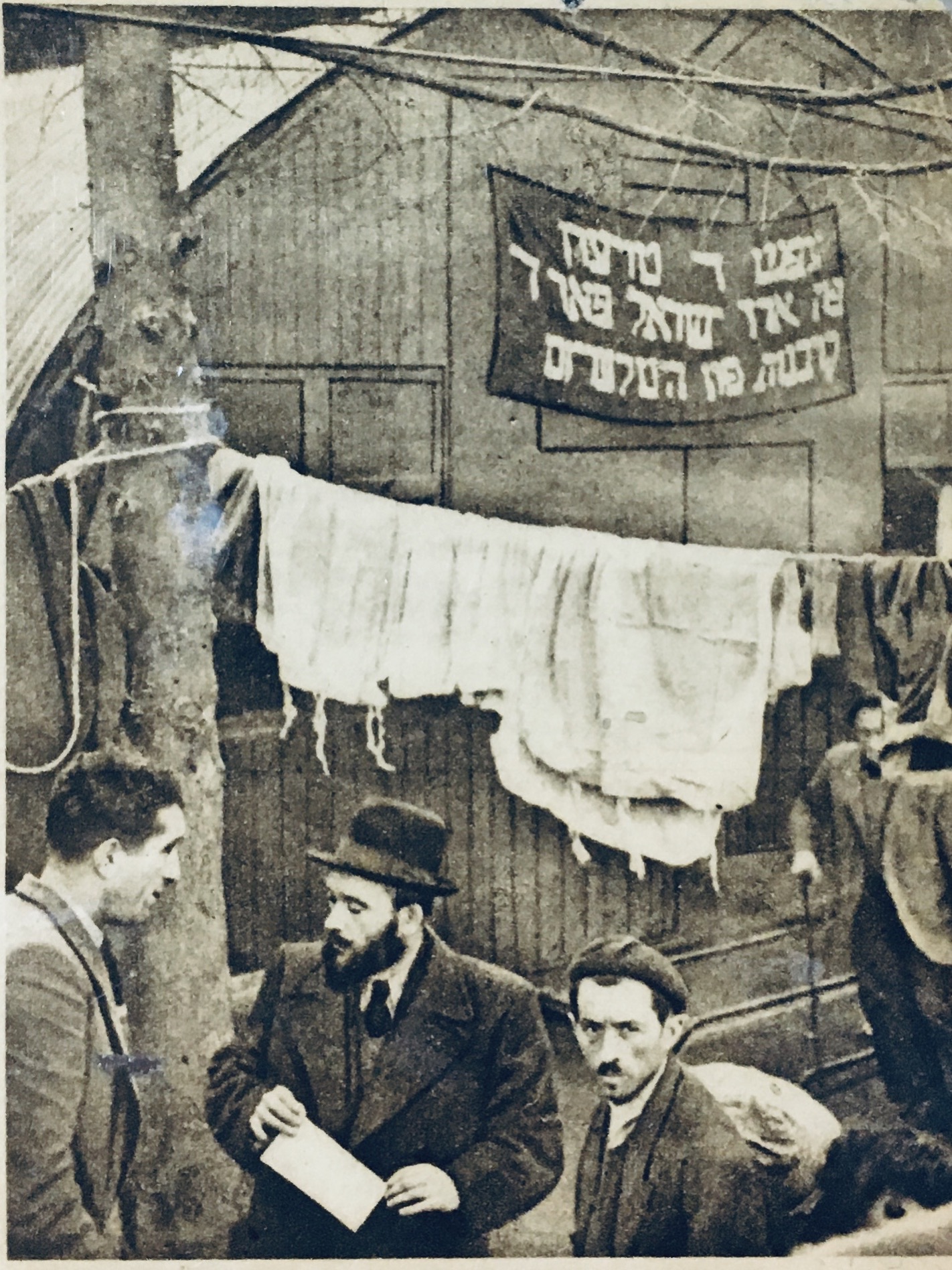|
Dovid Biderman
Grand Rabbi Dovid Biderman (1746-1814) of Lelów was the founder of the Lelov Hassidic dynasty. He is commonly referred to as "''Reb Dovid Lelover''". Biography Rabbi Dovid of Lelov was a disciple of the Seer of Lublin, a disciple of Rabbi Elimelech of Lizhensk, who was a disciple of the Magid of Mezritsh, the successor to and leading disciple of the Baal Shem Tov, the founder of Hasidism. There is a Hasidic legend that Napoleon Bonaparte asked Rabbi Dovid of Lelov if he would be successful in his conquest of Russia. The rebbe told the Emperor that he would not. After Napoleon's defeat, he allegedly passed through Lelov and told the Rebbe that he was indeed correct. He then gave the Rebbe his velvet cloak. The Hasidim say that Rabbi Moshe of Lelov, the son of Rabbi Dovid, took the cloak to Jerusalem with him, and made the cover for the Holy Ark in his synagogue A synagogue, also called a shul or a temple, is a place of worship for Jews and Samaritans. It is a plac ... [...More Info...] [...Related Items...] OR: [Wikipedia] [Google] [Baidu] |
Lelov
Lelov () is a Polish-Israeli Hasidic dynastic court, which traces its origins to the town of Lelów, Poland where the court was established in 1815 by Rabbi Dovid Biderman (1746-1814). The Lelover dynasty migrated from Poland to Jerusalem when Biderman's son, Rabbi Moshe Biderman (1776-1851), the son-in-law of Rabbi Yaakov Yitzchak Rabinowicz, moved there in the last year of his life. In the 21st century several descendants of the dynasty are Lelover rebbes, in Bnei Brak, Jerusalem, Beit Shemesh and Brooklyn. History Dovid Biderman of Lelov was a disciple of the Yaakov Yitzchak, known as the Seer of Lublin. The early Lelover rebbes (starting with Dovid Tzvi Shlomo) were followers of the Karlin (Hasidic dynasty). Outline of Lelover dynasty *Grand Rabbi Dovid of Lelov (1746-1814) **Grand Rabbi Moshe Biderman of Lelov (1776-1851) ***Grand Rabbi Eleazar Mendel Biderman of Lelov (1827-1882) ****Grand Rabbi Dovid Tzvi Shlomo Biderman of Lelov (1844-1918) *****Grand Rabbi Shimon ... [...More Info...] [...Related Items...] OR: [Wikipedia] [Google] [Baidu] |
French Invasion Of Russia
The French invasion of Russia, also known as the Russian campaign (), the Second Polish War, and in Russia as the Patriotic War of 1812 (), was initiated by Napoleon with the aim of compelling the Russian Empire to comply with the Continental System, continental blockade of the United Kingdom. Widely studied, Napoleon's incursion into Russia stands as a focal point in military history, recognized as among the list of battles by casualties, most devastating military endeavors globally. In a span of fewer than six months, the campaign exacted a staggering toll, claiming the lives of nearly a million soldiers and civilians. On 24 June 1812 and subsequent days, the initial wave of the multinational Grande Armée crossed the Neman River, marking the entry from the Duchy of Warsaw into Russia. Employing extensive forced marches, Napoleon rapidly advanced his army of nearly half a million individuals through European Russia, Western Russia, encompassing present-day Belarus, in a b ... [...More Info...] [...Related Items...] OR: [Wikipedia] [Google] [Baidu] |
Orthodox Judaism In Poland
Orthodox, Orthodoxy, or Orthodoxism may refer to: Religion * Orthodoxy, adherence to accepted norms, more specifically adherence to creeds, especially within Christianity and Judaism, but also less commonly in non-Abrahamic religions like Neo-paganism or Hinduism Christian Traditional Christian denominations * Eastern Orthodoxy, which accepts the theological resolutions of the Council of Chalcedon * Oriental Orthodoxy, which does not accept the theological resolutions of the Council of Chalcedon Modern denominations * Lutheran orthodoxy, an era in the history of Lutheranism which began in 1580 from the writing of the ''Book of Concord'' * Neo-orthodoxy, a theological position also known as ''dialectical theology'' * Orthodox Presbyterian Church, a confessional Presbyterian denomination located primarily in the northern United States * Paleo-orthodoxy, (20th–21st century), a movement in the United States focusing on the consensus among the ecumenical councils and church fath ... [...More Info...] [...Related Items...] OR: [Wikipedia] [Google] [Baidu] |
Jewish Polish History
The history of the Jews in Poland dates back at least 1,000 years. For centuries, Poland was home to the largest and most significant Jews, Jewish community in the world. Poland was a principal center of Jewish culture, because of the long period of statutory toleration, religious tolerance and Qahal, social autonomy which ended after the Partitions of Poland in the 18th century. During World War II there was a nearly complete genocide, genocidal destruction of the Polish Jewish community by Nazi Germany and its collaborators of various nationalities, during the German occupation of Poland between 1939 and 1945, called the Holocaust. Since the fall of communism in Poland, there has been a renewed interest in Jewish culture, featuring an annual Jewish Culture Festival, new study programs at Polish secondary schools and universities, and the opening of Warsaw's Museum of the History of Polish Jews. From the founding of the Kingdom of Poland (1025–1385), Kingdom of Poland in 10 ... [...More Info...] [...Related Items...] OR: [Wikipedia] [Google] [Baidu] |
Yeshiva University
Yeshiva University is a Private university, private Modern Orthodox Judaism, Orthodox Jewish university with four campuses in New York City."About YU on the Yeshiva University website The university's undergraduate schools—Yeshiva College (Yeshiva University), Yeshiva College, Stern College for Women, Katz School of Science and Health, and Sy Syms School of Business—offer a dual curriculum inspired by Modern Orthodox Judaism, Modern–Centrist Orthodoxy, Centrist–Orthodox Judaism, Orthodox Judaism's ''hashkafa'' (philosophy) of ''Torah Umadda'' ("Torah and secular knowledge"), which synthesizes a secular academic education with the study of the Torah. The majority of students at the university identify as Modern Orthodox Judaism, Modern Orthodox. The undergraduate body is entirely Jewish, [...More Info...] [...Related Items...] OR: [Wikipedia] [Google] [Baidu] |
Stitcher
Stitcher was a media company that specialized in the creation, distribution, and monetization of podcasts. Stitcher created original shows through networks such as Earwolf and Witness Docs. Stitcher provided ad sales and distribution services to 300+ shows. Stitcher was home to one of the largest podcast listening apps. In July 2020, it was acquired by SiriusXM. The acquisition was finalized by 19 October 2020. History Stitcher was founded in 2008 by Noah Shanok, Mike Ghaffary, and Peter deVroede. The company began with just its listening app, entitled "Stitcher", and was venture-backed until 2014 when the company was acquired by Deezer. In 2016, Deezer sold Stitcher for $4.5 million to Midroll Media, a digital media company founded in 2012 which had been acquired by E.W. Scripps Company in 2015. In 2017, Midroll Media underwent a rebranding, making Stitcher the parent company to Midroll Media and Earwolf, another entity under the E.W. Scripps network. In July 2020, Sirius XM ... [...More Info...] [...Related Items...] OR: [Wikipedia] [Google] [Baidu] |
Shlomo Zev Zweigenhaft
Shlomo Zev Zweigenhaft (Hebrew: ) was a rabbi and Rosh Hashochtim of Poland (overseeing the country's kosher slaughterers) before the Holocaust. After the Holocaust he was Chief Rabbi of Hanover and Lower Saxony. After emigrating to the United States he was a Rav Hamachshir (kosher certifier) and was described as the "foremost authority on shechita" (kosher slaughter). Early life Family Rabbi Zweigenhaft was born in Sosnowiec Poland in 1915. His mother, Michla, was a daughter of Meir Dovid Reinhertz, a Rabbi who was a son of the Rabbi of Yanov and a grandson of the Rabbi of Przedbórz. Zweigenhaft's father, Rabbi Moshe Chaim, was a shochet (kosher slaughterer) and a student of Avrohom Bornsztain. Zweigenhaft was orphaned at the age of two and was raised by his paternal grandfather, Efraim Mordechai Mottel Zweigenhaft, who was a posek and shochet in Sosnowiec and a descendant of David HaLevi Segal and Joel Sirkis. Education Rabbi Zweigenhaft studied at a Radomsker cheder i ... [...More Info...] [...Related Items...] OR: [Wikipedia] [Google] [Baidu] |
Arizona
Arizona is a U.S. state, state in the Southwestern United States, Southwestern region of the United States, sharing the Four Corners region of the western United States with Colorado, New Mexico, and Utah. It also borders Nevada to the northwest and California to the west, and shares Mexico-United States border, an international border with the Mexican states of Sonora and Baja California to the south and southwest. Its Capital city, capital and List of largest cities, largest city is Phoenix, Arizona, Phoenix, which is the most populous state capital and list of United States cities by population, fifth most populous city in the United States. Arizona is divided into 15 List of counties in Arizona, counties. Arizona is the list of U.S. states and territories by area, 6th-largest state by area and the list of U.S. states and territories by population, 14th-most-populous of the 50 states. It is the 48th state and last of the contiguous United States, contiguous states to be a ... [...More Info...] [...Related Items...] OR: [Wikipedia] [Google] [Baidu] |
Chabad
Chabad, also known as Lubavitch, Habad and Chabad-Lubavitch (; ; ), is a dynasty in Hasidic Judaism. Belonging to the Haredi (ultra-Orthodox) branch of Orthodox Judaism, it is one of the world's best-known Hasidic movements, as well as one of the largest Jewish religious organizations. Unlike most Haredi groups, which are self-segregating, Chabad mainly operates in the wider world and caters to nonobservant Jews. Founded in 1775 by Rabbi Shneur Zalman of Liadi (1745–1812) in the city of Liozno in the Russian Empire, the name "Chabad" () is an acronym formed from the three Hebrew words— Chokmah, Binah, Da'at— for the first three sefirot of the kabbalistic Tree of Life after Keter: , "Wisdom, Understanding, and Knowledge"—which represent the intellectual and kabbalistic underpinnings of the movement. The name Lubavitch derives from the town in which the now-dominant line of leaders resided from 1813 to 1915. Other, non-Lubavitch scions of Chabad either disappear ... [...More Info...] [...Related Items...] OR: [Wikipedia] [Google] [Baidu] |
Synagogue
A synagogue, also called a shul or a temple, is a place of worship for Jews and Samaritans. It is a place for prayer (the main sanctuary and sometimes smaller chapels) where Jews attend religious services or special ceremonies such as weddings, bar and bat mitzvahs, choir performances, and children's plays. They often also have rooms for study, social halls, administrative and charitable offices, classrooms for religious and Hebrew studies, and many places to sit and congregate. They often display commemorative, historic, or modern artwork alongside items of Jewish historical significance or history about the synagogue itself. Synagogues are buildings used for Jewish prayer, study, assembly, and reading of the Torah. The Torah (Pentateuch or Five Books of Moses) is traditionally read in its entirety over a period of a year in weekly portions during services, or in some synagogues on a triennial cycle. However, the edifice of a synagogue as such is not essential for hol ... [...More Info...] [...Related Items...] OR: [Wikipedia] [Google] [Baidu] |
Holy Ark
A Torah ark (also known as the ''hekhal'', , or ''aron qodesh'', ) is an ornamental chamber in the synagogue that houses the Torah scrolls. History The ark is also known as the ''ark of law'', or in Hebrew the ''Aron Kodesh'' () or ''aron ha-Kodesh'' ('holy ark') in Ashkenazi communities and as the '' Hekhal'' ('sanctuary') among Sefardi communities. The name ''Aron Kodesh'' is a reference to the Ark of the Covenant, which was stored in the Holy of Holies in the inner sanctuaries of both the ancient Tabernacle and the Temple in Jerusalem. Similarly, ''Hekhál'' ( 'palace'; also written ''hechal'', ''echal'', ''heichal'' or ''Echal Kodesh''—mainly among Balkan Sephardim) was used in the same time period to refer to the inner sanctuary. The ''hekhal'' contained the Menorah, Altar of Incense and Table of the Showbread. Customs and location In some ancient synagogues, such as the fifth-century synagogue in Susya, the Torah scroll was not placed inside the synagogue at all, bu ... [...More Info...] [...Related Items...] OR: [Wikipedia] [Google] [Baidu] |








